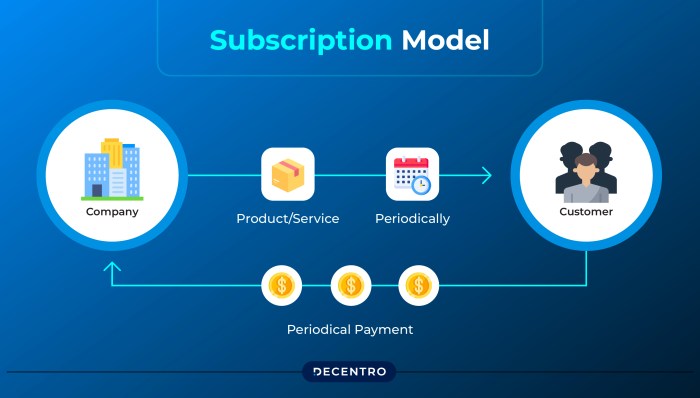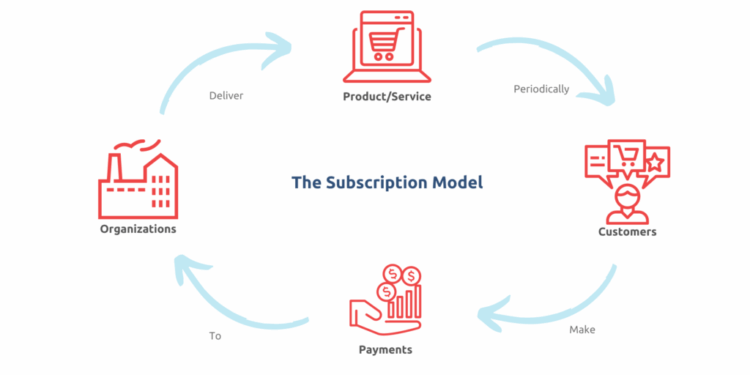
Diving into the realm of subscription-based market models, we uncover the intricacies and advantages that shape modern business strategies. From SaaS to product-based subscriptions, this overview delves into the dynamic landscape of subscription models.
Overview of Subscription-based Market Models
Subscription-based market models involve customers paying a recurring fee at regular intervals to access a product or service. This model has gained significant popularity in modern business practices due to its ability to create predictable revenue streams and foster long-term customer relationships.
Significance of Subscription Models
Subscription models are crucial for businesses as they provide a steady income flow, allowing for better financial planning and forecasting. By offering subscriptions, companies can enhance customer loyalty and engagement, leading to higher customer lifetime value and reduced churn rates.
Examples of Industries Utilizing Subscription-based Models
- Streaming services like Netflix, Spotify, and Amazon Prime
- Software companies offering SaaS (Software as a Service) solutions
- Subscription boxes for beauty products, snacks, and clothing
- Newspapers and magazines with digital subscription options
Benefits of Subscription-based Market Models for Businesses
- Stable Revenue: Predictable income streams that aid in financial stability and planning.
- Customer Retention: Enhanced customer loyalty and reduced churn rates.
- Upselling Opportunities: Ability to cross-sell and upsell additional products or services to existing subscribers.
- Data Insights: Access to valuable customer data for personalized marketing and product development.
Types of Subscription-based Market Models
Subscription-based market models come in various forms, each catering to different industries and customer needs. Let's explore the different types of subscription models, compare and contrast them, and understand how pricing strategies play a crucial role in their success.
SaaS (Software as a Service)
Software as a Service is a subscription model where users pay a recurring fee to access software applications over the internet. This model is popular among businesses as it offers flexibility, scalability, and cost-effectiveness.
- Examples: Microsoft 365, Adobe Creative Cloud, Salesforce
Product-based Subscription
In this model, customers subscribe to receive physical products on a regular basis. This type of subscription model is common in industries such as beauty, food, and fashion, where customers prefer the convenience of having products delivered to their doorstep.
- Examples: Birchbox, HelloFresh, Stitch Fix
Content-based Subscription
Content-based subscription models provide users with access to exclusive content, such as articles, videos, or podcasts, in exchange for a subscription fee. This model is popular among media companies, bloggers, and online course creators.
- Examples: Netflix, Spotify, The New York Times
Pricing Strategies
Subscription models vary based on pricing strategies, including tiered pricing, freemium models, and usage-based pricing. Companies need to choose the right pricing strategy based on their target audience and the value they provide.
Successful Companies Using Different Models
Several companies have successfully implemented various subscription models to drive growth and revenue. These companies have leveraged subscription-based market models to build a loyal customer base and create recurring revenue streams.
- SaaS:Salesforce offers a range of CRM and business management tools through its subscription-based model.
- Product-based:Stitch Fix delivers personalized clothing items to customers based on their style preferences.
- Content-based:Netflix provides a vast library of movies and TV shows for subscribers to stream on demand.
Consumer Behavior and Subscription Models
Consumer behavior plays a crucial role in the success of subscription-based market models. Understanding consumer preferences and motivations can help companies tailor their offerings to meet the needs of their target audience.
Consumer Preferences Towards Subscription-Based Services
Consumer preferences towards subscription-based services are influenced by factors such as convenience, cost-effectiveness, and personalization. Subscribers often value the convenience of having products or services delivered to them regularly without the need to reorder. Additionally, subscription models can offer cost savings compared to traditional purchasing, especially for products that are used frequently.
Personalization is another key factor, as consumers appreciate tailored recommendations and curated experiences based on their preferences.
Factors Influencing Consumers to Choose Subscription Models Over Traditional Purchasing
Several factors influence consumers to choose subscription models over traditional purchasing. These include the desire for convenience and time-saving benefits, the appeal of a predictable pricing structure, the ability to try new products without committing to a full purchase, and the perceived value of receiving products or services on a regular basis.
Subscription models also offer a sense of exclusivity and customization that can attract consumers looking for unique experiences.
Leveraging Consumer Behavior Data to Optimize Subscription Offerings
Companies leverage consumer behavior data to optimize subscription offerings by analyzing customer preferences, purchasing patterns, and feedback. By tracking data such as product preferences, frequency of purchases, and customer feedback, companies can personalize their offerings, improve customer satisfaction, and increase retention rates.
This data-driven approach allows companies to tailor their subscription services to better meet the needs and preferences of their customers.
Customer Retention Strategies Within Subscription-Based Businesses
Customer retention is crucial for the long-term success of subscription-based businesses. To improve customer retention, companies often focus on providing exceptional customer service, offering incentives for loyal customers, regularly engaging with subscribers through personalized communication, and continuously updating and improving their offerings based on customer feedback.
By implementing effective customer retention strategies, companies can increase customer loyalty, reduce churn rates, and drive sustainable growth in their subscription-based business.
Challenges and Opportunities in Subscription-based Market Models
Subscription-based market models come with their own set of challenges and opportunities that companies need to navigate to succeed in this competitive landscape.
Common Challenges Faced by Companies Implementing Subscription Models
Implementing subscription models can be challenging due to various factors such as:
- Customer retention: Keeping subscribers engaged and preventing churn is a constant challenge for companies.
- Pricing strategy: Setting the right price that is attractive to customers while ensuring profitability can be tricky.
- Competition: The market is saturated with subscription services, making it difficult to stand out.
- Value proposition: Clearly communicating the value of the subscription and differentiating it from competitors is crucial.
Strategies to Overcome Subscription Model Challenges
To overcome these challenges, companies can implement the following strategies:
- Focus on customer experience: Providing excellent customer service and personalized experiences can increase retention rates.
- Experiment with pricing: A flexible pricing strategy that offers different tiers or add-ons can cater to a wider range of customers.
- Invest in marketing: Creating compelling content and targeted marketing campaigns can help attract and retain subscribers.
- Monitor competition: Keeping an eye on competitors can help companies stay ahead of trends and adjust their strategies accordingly.
Emerging Trends and Opportunities in the Subscription-based Market
The subscription-based market is constantly evolving, with new trends and opportunities emerging, such as:
- Subscription box services: Curated boxes offering personalized products have gained popularity in recent years.
- Subscription-based software: Software companies are moving towards subscription models to provide ongoing updates and support.
- Membership models: Companies are offering subscription-based memberships with exclusive perks and benefits to attract and retain customers.
Examples of Companies Adapting Successfully to Changing Subscription Trends
Several companies have successfully adapted to changing subscription trends, including:
- Netflix: Transitioning from a DVD rental service to a streaming platform with a monthly subscription model.
- Amazon Prime: Offering a subscription service with benefits like fast shipping, streaming services, and exclusive deals.
- Sephora Play: Providing a monthly beauty subscription box with curated products for makeup enthusiasts.
Summary

In conclusion, subscription-based market models offer a promising avenue for businesses to foster customer loyalty and drive sustainable revenue streams. As companies navigate through challenges and embrace opportunities, the subscription model landscape continues to evolve, shaping the future of commerce.
FAQ Corner
What are the key benefits of subscription-based market models?
Subscription models provide businesses with recurring revenue, increased customer loyalty, and valuable insights into consumer behavior.
How do subscription models differ based on pricing strategies?
Subscription models can vary in pricing strategies such as tiered pricing, usage-based pricing, or flat-rate pricing, catering to different customer segments.
What industries have successfully implemented subscription-based models?
Industries like software, media streaming, and beauty products have effectively utilized subscription models to enhance customer engagement and retention.
How do companies overcome challenges in implementing subscription models?
Companies can address challenges by offering flexible subscription plans, optimizing customer experiences, and continuously adapting to changing market trends.











